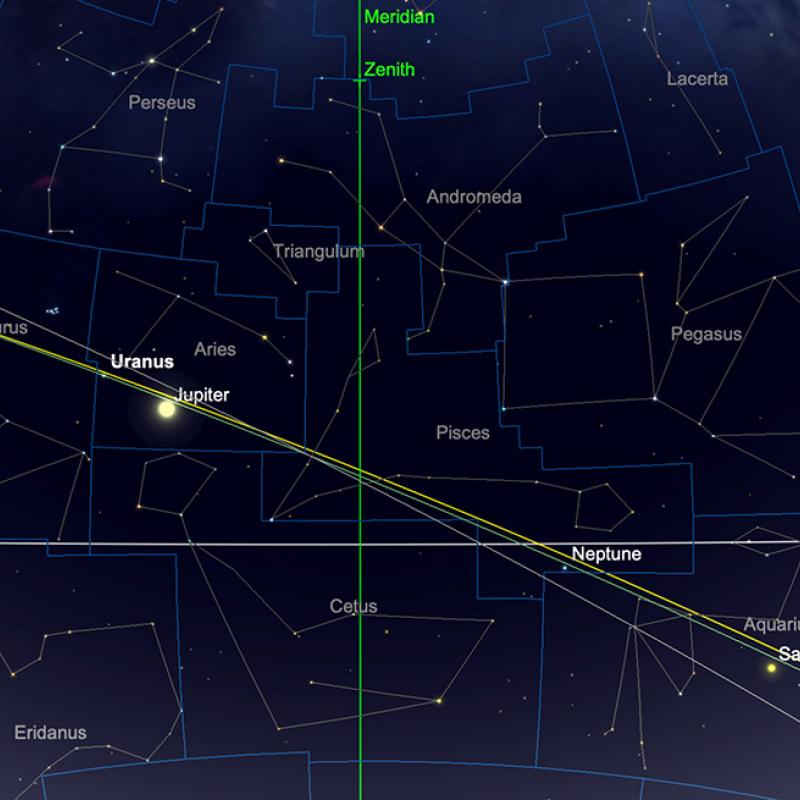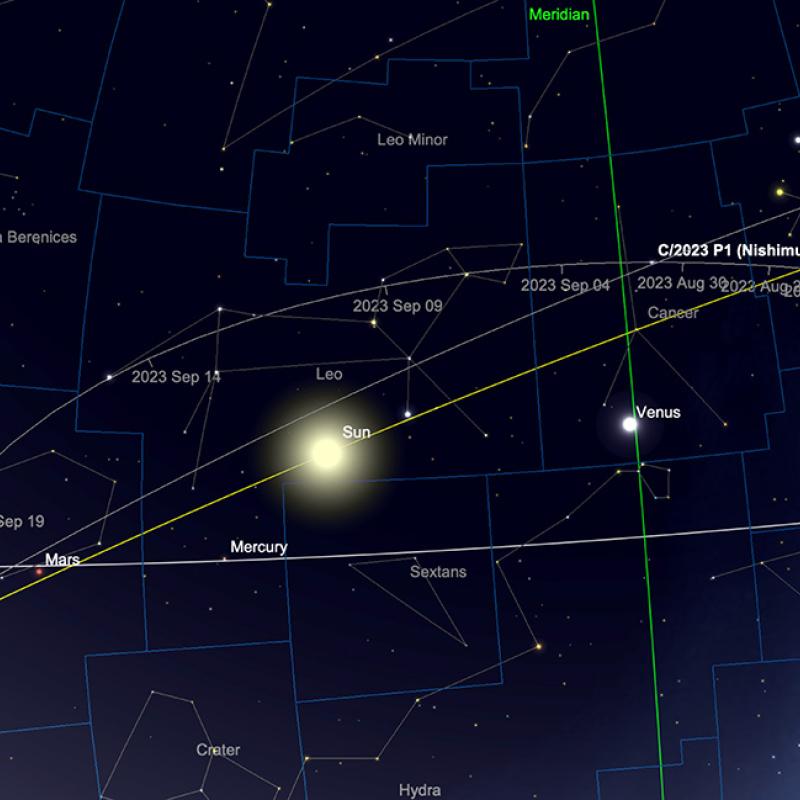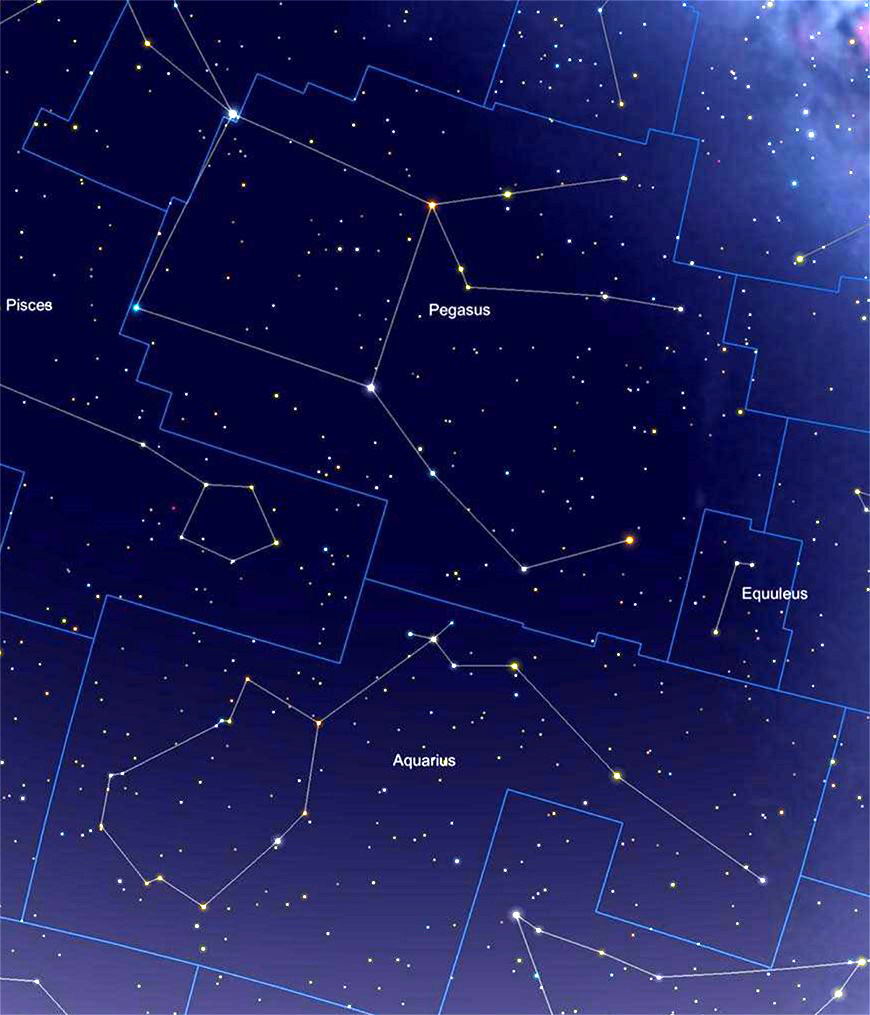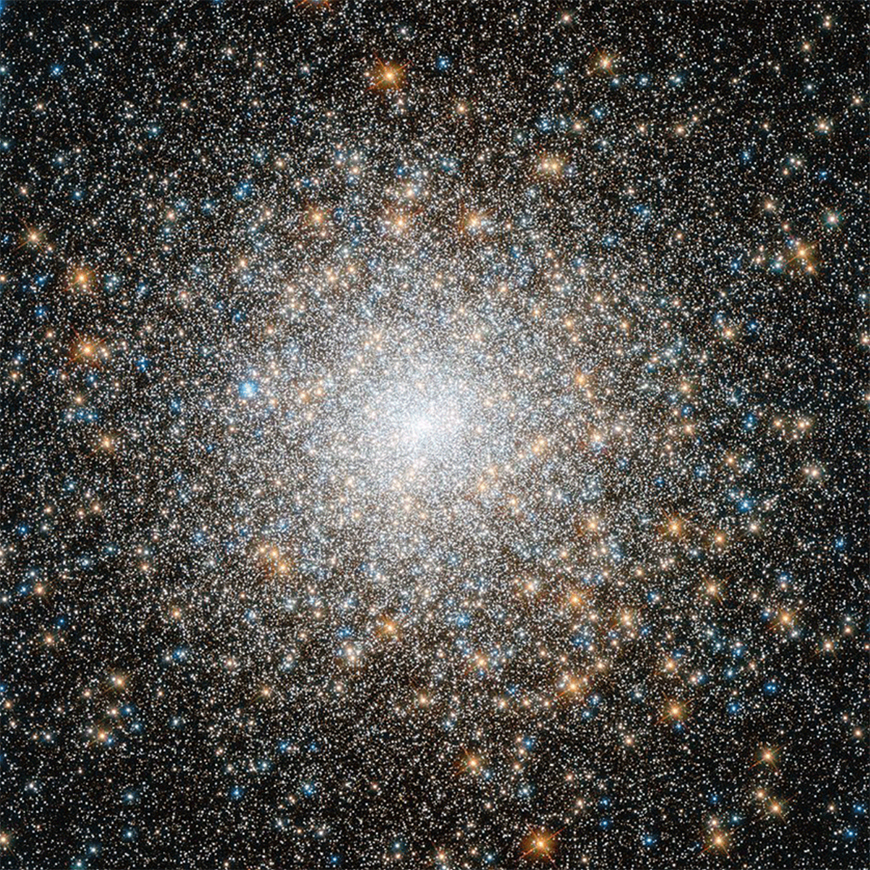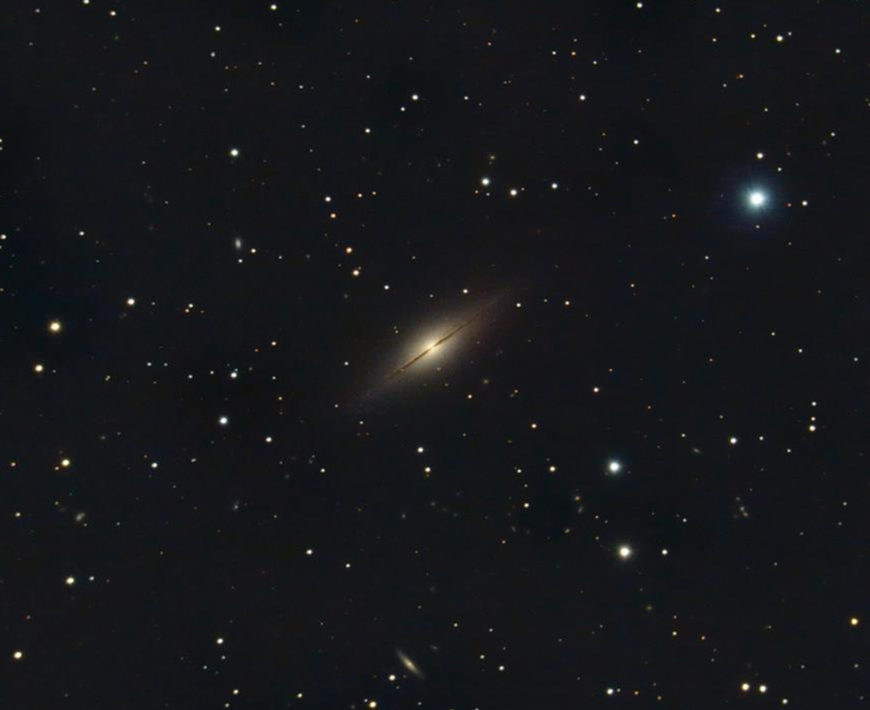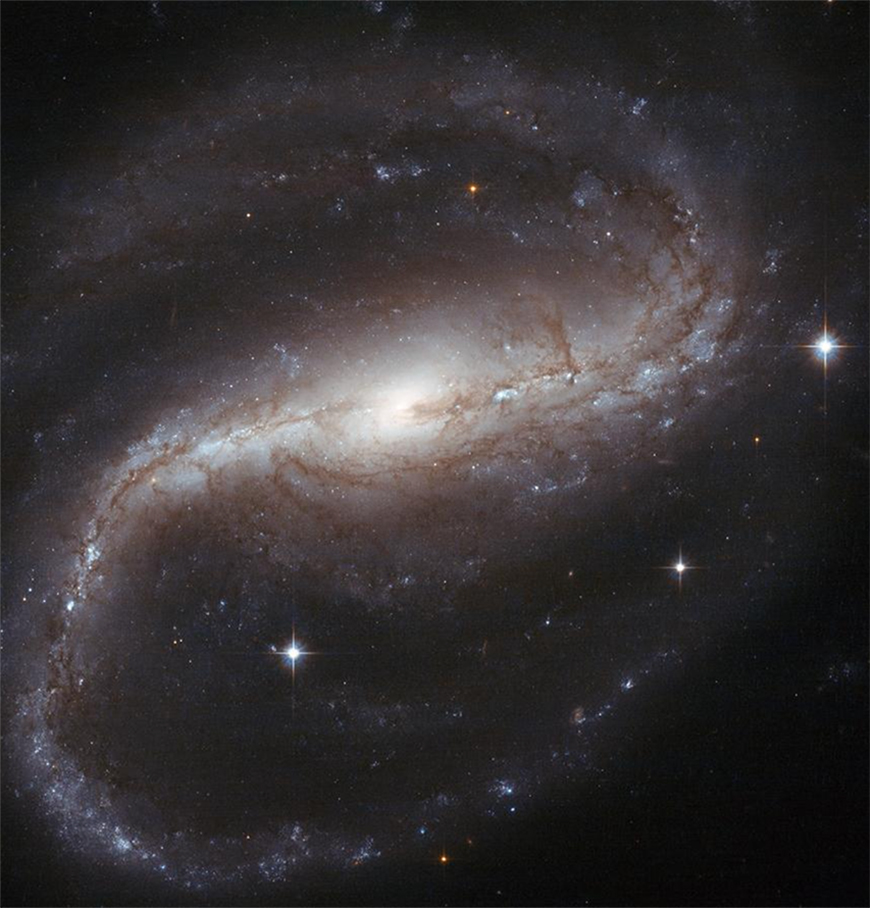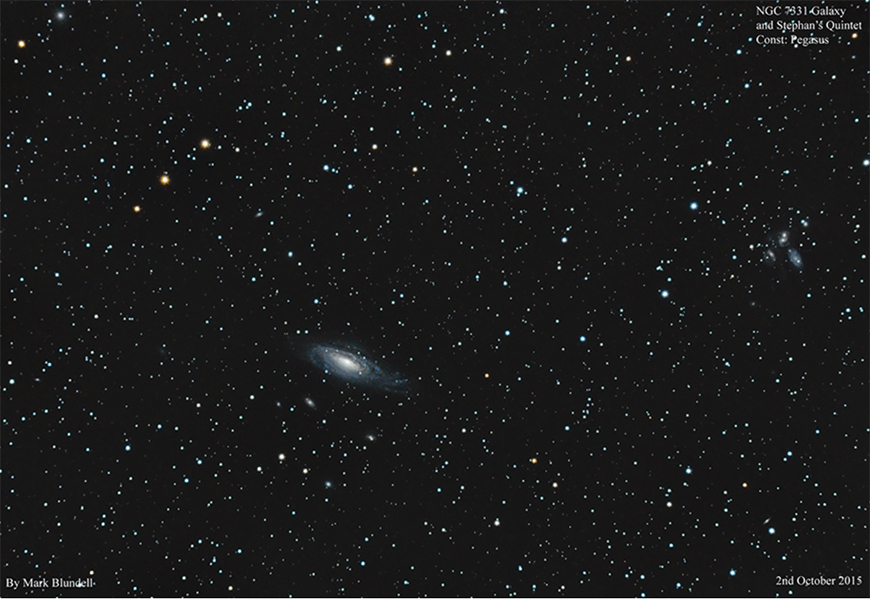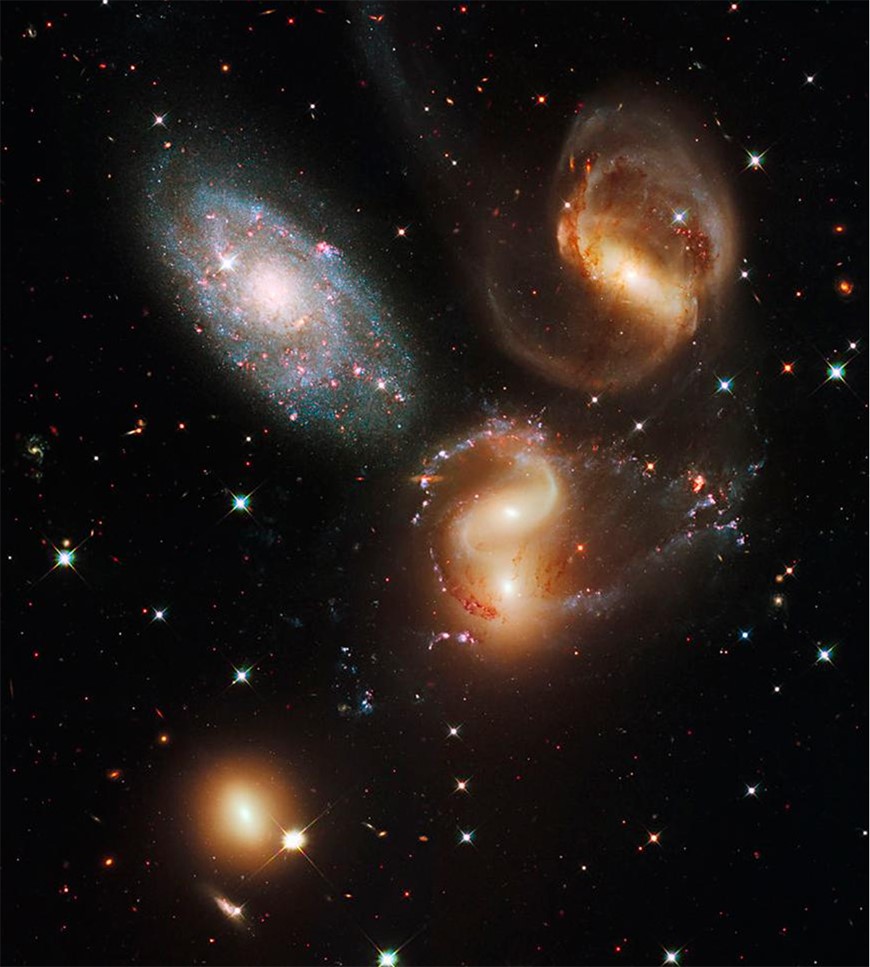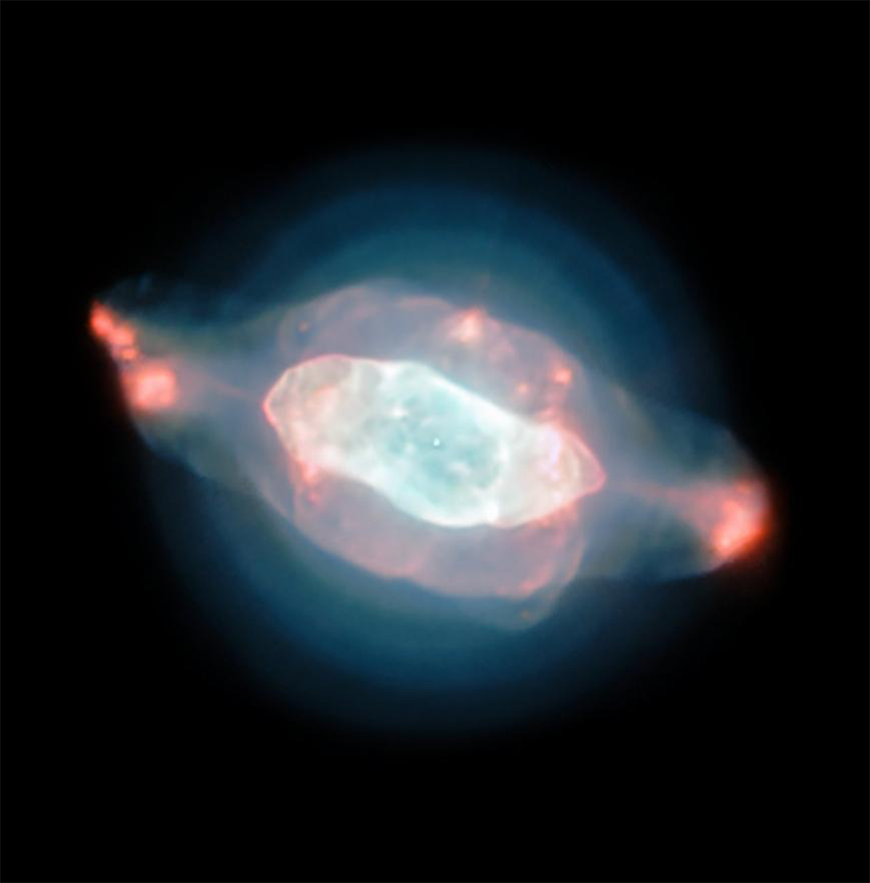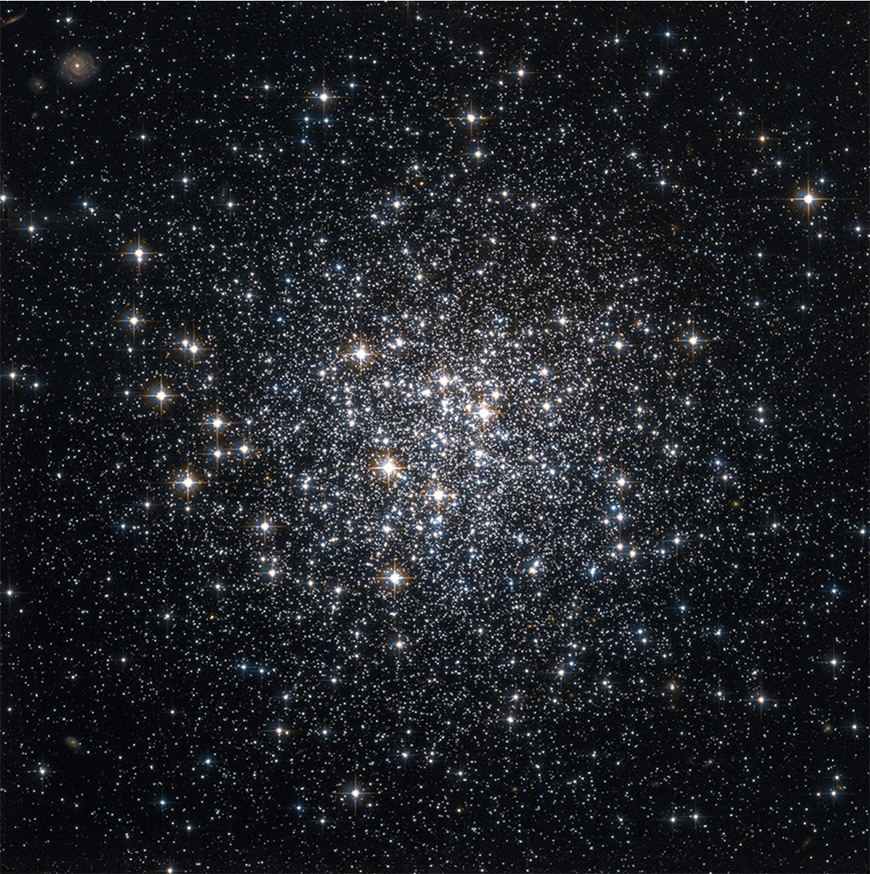Saturn
At just past opposition (reached on August
27th), Saturn is ideally, placed for observation throughout the night.
Currently found in the constellation of Aquarius, Saturn presents a visual
magnitude of +0.4 and an apparent size of 19 arc seconds across at the month’s beginning. Saturn rises at just before 8
pm on the 1st, transits a little before 1 am the following morning and sets at
around 6 am.
The early morning of the 1st also sees an
interesting Saturnian transit event, when the moon Tethys moves in front of
Saturn’s disk. Transits of Saturn’s moons are a much more challenging event to observe than those of
Jupiter’s Galilean satellites. You will need a telescope
of probably around 10 inches in aperture, as a minimum - and it is much more
likely that you will see the shadow of the moon’s transit, rather than the moon itself,
against Saturn’s atmosphere. Conditions will have to be very clement and the
atmosphere extremely steady to make observations of this sort. However, the
morning of the first see Saturn at a reasonable altitude above the horizon and
while it would require an alignment of favourable circumstances and pretty
healthy magnification, for those with the prerequisite equipment, observing
skill, and patience, is not impossible.
By the time we get to mid September, Saturn
will have faded very fractionally to a visual magnitude +0.5. The planet will
rise at a little before 7 pm and transit at just before midnight. It will set
around 5 am the following morning.
At the end of the month, Saturn will faded
a little further 2+0.6 magnitude and now displays and 18.6 ox second diameter
disc. The planet rises a little before 6 pm, transiting at a little before 11
in the evening and sitting at just before 4 am the following morning.
Post-opposition is always the most favourable time for observation of an outer
planet in the evening and we are heading towards this window of observational
opportunity as far as Saturn is concerned. Anyone with a telescope is
thoroughly encouraged to make the most of this opportunity. Like Jupiter,
Saturn is now rising from the doldrums of the southern part of the ecliptic,
which it has occupied for the best part of a decade now. While it is nowhere
near as high in the sky as its neighbour, Jupiter, the trend for northern
hemisphere observation is definitely upwards as far as Saturn is concerned.
Standing just under 27° high at transit point on
the 30th, Saturn presents a very reasonable target for northern hemisphere
observers. Time spent at the eyepiece observing Saturn is rarely wasted - so
make the most of it.
Uranus and Neptune
Of the two out gas giants, the focus is
predominantly on Neptune this month, as it comes to opposition on 19th
September. In truth, oppositions of both outer worlds, never result in a massive
boost in brightness, as they are both so far away from us here on Earth, even
at the best of times. The 19th will find Neptune a resident in Pisces at a
visual magnitude of +7.8 and displaying a disc of 2.4 seconds diameter.
Neptune was first identified through
mathematical prediction. While Galileo observed Neptune near Jupiter in 1612
and 1613, he mistook it for a star. After Sir William Herschel's discovery of
Uranus in 1781, anomalies in the observation of the planet’s orbit hinted at another distant planet,
further out in the icy reaches of the solar system. English astronomer John
Couch Adams and French mathematician Urbain Le Verrier separately calculated
its potential location. Their predictions, initially overlooked, were later
recognised for their accuracy. However, due to outdated star maps and
communication issues, Neptune was observed, but not identified by the British.
Meanwhile, Le Verrier shared his predictions with the Berlin Observatory.
Resident Astronomers Johann Galle and Henrich d’Arrest found Neptune within an hour of
searching on 24th September 1846, very close (within a degree) of Le Verrier’s predicted location.
Neptune’s prominent blue colouration is often
remarked upon. When you find it in a telescope, or larger binoculars, it is
faint, but pretty unmistakable, often being described as looking akin to a
planetary nebula itself. Around opposition gives us the best opportunity to
observe the solar system’s (current) last “true” planet.
Further east in the ecliptic, lies Neptune’s neighbour, Uranus. A resident of Aries
currently, the prominent planet, Jupiter situated around seven and
three-quarter degrees to the west of Uranus acts as a handy signpost for its
location. At +5.7 magnitude, Uranus is technically a naked eye object, but is
much easier to find in binoculars. Its greeny-grey disc, again, looks quite
similar to a brighter planetary nebula and at 3.7 arc seconds diameter it is
similar in size to many. Given a significantly large telescope (usually 12
inches or above in aperture), it is possible to visually observe some striation
on Uranus’ disk, during times of good seeing. Experienced observers have managed
to glimpse some subtle albedo features with smaller telescopes, but have
doubtlessly been extremely patient and methodical in their observation
techniques. As Uranus is now the most northerly of all the planets in the sky,
northern hemisphere observers are encouraged to make the most of its position.
As Uranus transits during September, it will stand around 57 1/2° above the horizon (as seen from 51° north).
Comets
A newly-discovered comet, C/2023 P1
(Nishimura) has been causing some speculation and it looks like it may be
observable during September. Very early in the month, the comet may be
observable in the early morning sky, predawn. However, it will loop north of
the Sun around mid-September and will likely be unobservable during this period
- unless something remarkable happens. Once the comet reemerges from the Sun’s glare in the latter half of the month, it
will be an evening target. Current peak
magnitude predictions put it as high as second magnitude, though this is likely
to occur when the comet is very close to the Sun, making it very difficult to
observe. Still, this is an interesting object and we encourage those up early
enough in the early part of the month to see if they can find it using larger
binoculars. The comet may be easier to observe post-perihelion in the latter
part of the month, but it remains to be seen exactly how this comet will
manifest itself.
We still have the potential of comets,
C/2021 S3 and C/2023 A3 to look forward to, but it will really be 2024 before
either are at their best.
Meteors
There are no major meteor showers which
peak in September. The Southern Taurids
Shower begins around 10th September, but peaks on, or around 10th October. The
Taurids are noted for fireball events, many of which have been caught on
camera. However, the shower itself is quite sparse, reaching a Zenithal Hourly
Rate of around five.
The next recognised major showers are the
Draconids and Orionids of October.
Even at times of low meteor shower
activity, sporadic meteors can appear from any direction in the sky and if you
are out long enough during the night, away from moonlight, you’re likely to see some evidence of this.
Deep Sky Delights in Pegasus and Aquarius
The arrival of Pegasus and Aquarius in the
evening skies are a sure sign of the approach of Autumn. These two
fairly large constellations share a border and are home to some easy - and
not-so-easy - deep sky targets.
Though lacking in major nebulae, Pegasus is
a haven for galaxies - maybe not quite to the extent of the Virgo and Leo
regions - but has many extra-galactic targets worth attention.
The most famous feature of Pegasus is
readily observable without a telescope - this is, of course, the famous Square
of Pegasus. Consisting of the stars Alpheratz (Arabic for “the navel”),
Scheat (”the leg”), Algenib (”the flank”), Markab (”the saddle”), the Square of Pegasus dominates this
area of sky and can be used as a useful “jumping off”
guide for starhopping. However, the Square of Pegasus is not solely “of Pegasus”,
as Alpheratz is actually now officially a part of neighbouring Andromeda. This
is a similar situation to Elnath (Beta Tauri) which is officially now part of
Taurus, but has been shared as Gamma Aurigae with neighbouring Auriga. These
constellations are rare as they are still shown on modern star charts as
connected via their “shared” star.
A third of the way along the line between
the lower stars of the Square, Markab and Algenib, lies an object not visible
to the naked eye at all. This is the notable (if unspectacular) Pegasus Dwarf Galaxy,
This is an associated galaxy with the nearby M31, the Andromeda Spiral and as
such a neighbour of our own Milky Way. It’s a rather faint object at +13.2 mag and
spread out over a reasonable area of sky, so is only really detectable in long
duration photos. Dwarf galaxies are often (though not always) older, more
primitive than galaxies such as our own. However, whilst they are not brilliant
in the conventional visual sense, dwarf galaxies such as the Pegasus Dwarf are
havens for Dark Matter. The Pegasus Dwarf lies 3 million light years away from
the Milky Way and is tidally interactive with M31.
Much more easily-observed and better-known
is an object on the other side of Pegasus: the great globular cluster, M15.
Found 4 degrees north-east of the star Enif (Arabic for “nose”), or
Epsilon Pegasi, M15 is a glorious object in any telescope or binoculars and at
+6.2 mag can be seen as a naked eye object from a reasonable site. This
globular was discovered by Maraldi in September 1746 and catalogued 18 years
later by Messier in 1764. Located about 33600 light years away, M15 contains
around 100,000 stars. As a well-known object, it has been studied exhaustively
and found to contain the first extra-galactic planetary nebula discovered:
Pease 1, first identified in 1928. In addition to Pease 1, M15 has a pair of
co-orbiting neutron stars, 8 pulsars and two strong X-ray sources. It has been
postulated that one of these sources is in fact a Black Hole, to which has been
attributed M15’s relatively recent core collapse. Globular clusters are both beautiful
and intriguing objects and M15 is almost certain to contain more
as-yet-undiscovered features.
Back inside the Square of Pegasus lies the
lovely NGC7814 - the “Little Sombrero” (so called because it resembles the
Sombrero Galaxy, M104, in Virgo). NGC7814 is a Spiral, presented edge-on to our
line of sight. This reveals a dark dust lane bisecting a bright core. At +10.6
mag this galaxy isn’t overly bright, but due to its compact nature, is still well-seen in
small telescopes. NGC7814 is easily found due to its proximity to Algenib.
Another galaxy near to a member of The
Square is NGC7479, which lies just under 3 degrees south of Markab. This is one
of the most photogenic Barred Spirals in the sky, lying almost face on to us.
It was discovered in 1784 by William Herschel and is just slightly fainter than
7814 at +10.9 mag. NGC7479 is a very active galaxy - a so-called Seifert Type,
in which enormous amounts of star formation are taking place. The serpentine
structure of NGC7479 is beautifully depicted in long-duration photos - it
almost seems to be slithering like a Sidewinder through space!
Further north are a fascinating collection
of galaxies: the NGC7331 group and Stephan’s Quintet. These two groups of galaxies are
separated by just half a degree of sky and can be found north of Matar (Eta
Pegasi). Of the two groups, the NGC7331 group are the more conspicuous and
their principle member was discovered first - by William Herschel - in 1784.
This principle galaxy, NGC7331, was thought to be a very similar size, mass and
taxonomy to our own Milky Way: a tightly-barred spiral. However, most
up-to-date surveys of the Milky Way suggest that it may only have two massive
spiral arms, whereas NGC7331 has more (NGC6744 in Pavo is now seen to be the
nearest Milky Way analogue). Behind NGC7331 lie NGCs 7340, 7336, 7335, 7327 and
7338 - some of which can be seen with averted vision in reasonable-size
telescopes. NGC7331 at +9.5 mag is by far and away the most prominent of the
group and can be seen in smaller scopes. The whole group is a great target for
astrophotography as regular contributor Mark Blundell’s picture below clearly shows.
The second of these two galaxy groups is
the famous Stephan’s Quintet. Discovered in 1877 at Marseilles Observatory by Eduoard
Stephan, the Quintet consists of NGCs 7317, 7318, 7318A, 7318B, 7319 and 7320
(this is technically a Sextet as 7318A and B are separate galaxial cores).
Stephan’s Quintet occupies a tiny area of 3.5‘
x 3.5’
of sky and is an area of both
enormous destruction, as the component galaxies literally rip each other apart
and massive areas of creation where the resulting gas-rich loops of material
released by these dynamics leads to starbirth.
Of the components of the Quintet, NGC7320
appears to be an unrelated foreground object - much closer to us at 39 million
light years distance as opposed to the 210-350 million light years of the other
members.
Moving south into the Zodiacal
constellation of Aquarius, the Water Carrier, we are presented with a large,
but quite a barren area of sky. Although Aquarius is rather muted in terms of
brighter stars, it is a haven for deep sky objects. The most northerly of these
is the very fine globular cluster M2. At +6.46 mag, it is amongst the brighter
of these interesting objects, lying 37,500 light years away from us and about
175 light years in diameter. From Earth, it appears 2.1 arc minutes in
diameter, M2 is about the same relative size and brightness of the neighbouring
M15 and the second of Hercules’ well-known globulars, M92. Discovered by Comet Hunter Jean-Dominique
Maraldi in 1746, it languished in relative obscurity until Messier added it to
his list in 1760, describing it as a “Nebula without stars”. Modern instruments
show it as most definitely “with stars”, indeed there are several
beautiful star chains visible through telescopes, as well as some deep, dark
lanes and patches, adding to the “three-dimensionality” of the object,
particularly in larger telescopes. There are quite a mix of older orange and newer
blue stars within M2, making it a particularly pretty telescopic sight.
Moving SW from M2, we arrive at three
objects in quick succession: NGC 7009, The Saturn Nebula, the asterism M73 and
another globular, M72. The Saturn Nebula is a fascination Planetary Nebula,
well worth seeking out in any telescope, as it is reasonably bright, at +7.8
mag, yet compact at 0.5 arc minutes across. Telescopes of 6-8-inch aperture
will be needed in order to see the two extended lobes that give the object its
popular name. Lord Rosse, observing NGC 7009 in 1850, described two lobes or
projections sitting either side of the nebula, making it appear very similar to
Saturn, when its rings are edge on to us. Although the object has a distinctly
un-Saturn-like green-blue hue, which is most easily seen in long duration
photographs. The Saturn Nebula, in common with some other Planetaries -
including the Blinking Planetary - can appear to blink on and o when looking at
it for prolonged periods. This is of course a trick of the eye, caused by NGC
7009’s reasonably
bright central star overwhelming a dark-adapted observers eye. When the
observer averts their vision slightly, the Saturn Nebula returns to view.
Although the Blinking Planetary is the most well-known object that exhibits
this phenomenon, to the writer’s mind, the Saturn Nebula is actually the best example of a “Blinking”
Planetary Nebula. As ever, aperture helps in resolving the finer details of NGC
7009 (especially the projections), but the Saturn Nebula should be sought out
by all those with telescopes - it’s certainly bright enough to be seen in even the smallest scopes.
The next object is an interesting one. When
is a star cluster not a star cluster? Answer: when it’s an Asterism like M73. Lying less than 2
degrees SW of the Saturn Nebula, M73 has been the subject of some controversy
over the years since its discovery. Charles Messier first noted it in 1780 as a
“cluster of four stars with nebulosity”, although this nebulosity has
never been picked up by any other observers. John Herschel, whilst including it
in his General Catalogue, was suspicious of its definition as a true cluster.
Debate raged on throughout the 20th century as to the true nature of the
Y-shaped M73, with evidence of a relationship between the members of the group
being published for and against. The matter was finally and conclusively put to
bed in 2002, when spectral signatures of each of the constituent members,
gathered in high resolution, concluded that they were all moving in different
directions and the cluster was not, it fact, a cluster. M73 is not unique
amongst the Messier list for controversial description, but remains interesting
for the fact that it took so long to finally work out its true nature.
1.5 degrees to the west of M73 is the
slightly less controversial Globular Cluster M72. At +9.27 mag, it is
considerably fainter than M2, despite being not much smaller. M72 is
considerably further away from us than M2 - it lies 55,000 light years distance
from Earth. As it is fainter and further away, M72 requires a larger telescope
to resolve individual stars. It is a pleasing sight in a 10-inch reflector and
above, though William Herschel in his observing notes of 1783, noted that a
power of 150x was needed to resolve the individual stars “fairly”.

 English
English

